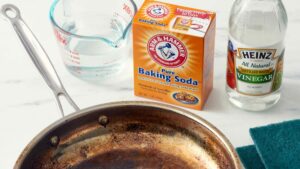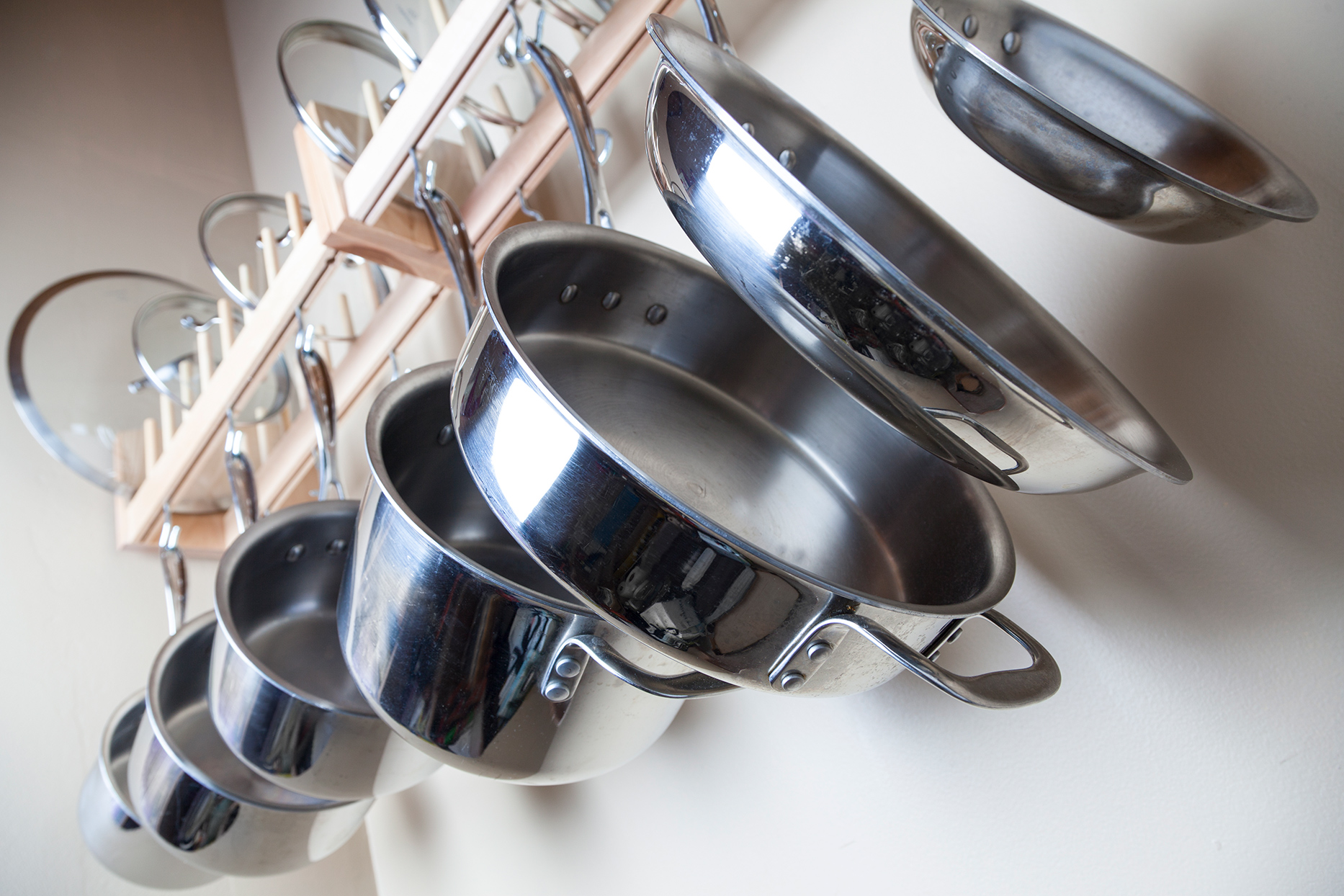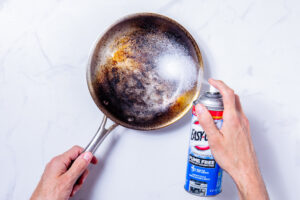Scenario 1: Discolored Pots and Pans
You’re ready to make a delicious meal, so you reach for your cookware set. When you grab it, you notice a rainbow-colored stain on your so-called stainless steel.
Why the Rainbow Stain Appears
The rainbow stain on stainless steel cookware can also be referred to as “heat tint.” Stainless steel is an excellent material for cooking pots and pans because it has chromium which helps it resist corrosion and rust. A protective layer forms on your pot or pan when chromium and air combine. When heated, the oxidized layer can thicken on even the most durable stainless steel. This layer is what causes the rainbow stain, which cannot be removed with scrubbing alone. Once the stain is seen, your first thought may be to throw your cookware away, but that is not necessary. The stain doesn’t affect performance, so there’s no need to dispose of anything. But since you simply do not like the look of the stained cookware, you decide to clean it up. How do you do it?
- Splash a bit of diluted white vinegar into your pot or pan.
- Use a sponge to hand wash the cookware. Make sure the sponge is non-abrasive.
- Rinse your cookware and fully dry it using a soft cloth to avoid water spots.
The entire process should take about a minute and once you are finished, your pots and pans will be as good as new!
Scenario 2: Oil Splatter
Fried chicken is one of the tastiest foods to make. However, like with other meals, oil can end up all over your kitchen as a result. At times, this mess can be tough to clean, and it may convince you not to cook with oil so much. Knowing what causes splatter and how to clean it may help you feel a little better about using oil.
- Dry off foods to reduce moisture before adding them to a hot pan.
- Only add cooking oil is the skillet is completely dry.
- Start your pan at a low heat and gradually increase the temperature.
We just covered what causes oil splatter. Now let’s look at some ways to clean it up.
Water and Dish Soap
With easy-clean pans like non-stick, some good old water and dish soap should do the trick. To remove oil, use hot water, mild dish soap, and the soft side of a dish sponge. Make sure the water is as hot as possible and use a good amount of pressure while working the soap into the stains. Once you are done scrubbing, rinse and thoroughly dry your cookware.
Vinegar
If soap isn’t tough enough, you can always try vinegar. Vinegar is a natural solvent, which makes it ideal for cleaning stubborn spills. Here’s two ways you can utilize vinegar to remove oil:
- For the first method, fill a spray bottle with distilled vinegar and spray over the oil spots. Let that sit for about 30 minutes so the vinegar can force the fat molecules from the surface. When ready, scrub the mess away with a sponge and rinse the surface with hot water.
- Another option would be to fill your sink or a large plastic container with vinegar and submerging your pot or pan into the liquid. After soaking for 30 minutes, scrub everything with a sponge and rinse. Don’t forget to dry the cookware.
Vinegar and Baking Soda
Vegetable Oil and Coarse Salt
f you wish to clean oil splatter off your carbon steel frying pan without removing any of the seasoning, then vegetable oil and salt is probably the best option for you. Just a small amount of each will get the job done. Finely ground table salt may not be as abrasive, so use larger crystals instead.
Using a paper towel, scrub the affected area in a circular motion. The abrasive salt mixed with the oil will act as a manual solvent that releases the excess oil splatter. The oil keeps the pan’s surface moisturized, while the salt will hold onto some oil. Plus, the seasoning of the pan is not affected. When you are done, wipe out the mixture with a clean paper towel.
Lemon Juice & Coarse Salt
Lemons contain citric acid, which is perfect for cleaning oil or fat molecules from surfaces.
Note:If you use acidic fruit such as lemons on cookware made of carbon steel, you may need to re-season it afterwards.
Take a halved lemon and dip it in some coarse salt, coating the cut face. Next, scrub away the spots using a circular motion. The acid will lift and break down the oil particles. Rinse and dry your pan once you are satisfied.
Degreasing Spray
If every other method fails, try a degreaser. Because it is full of chemicals, do not use this spray on cookware. However, it will do a great job at cleaning surfaces like backsplashes or any place where food will not be. Some popular brands of degreasing spray is WD-40 and Easy-Off. Make sure to follow the specific instructions on whatever can you use, but for the most part you’ll need to mildly saturate the affected and let it sit for 3-5 minutes. Rinse and dry when time is up.
Scenario 3: Rust

Baking Soda
Vinegar
How to Remove Rust from Cast Iron
Tips for Preventing Rust
- Let metal air dry.
- Drying with a microfiber towel will remove any water from pots and pans.
- If using any cast iron cookware, remember to routinely re-season it to prevent rust formation.
- Stainless less that contains chromium will help protect the metal from rusting.
- Allow any residual moisture to evaporate by placing rust-prone cookware face-down on a dish-drying rack.
- Place one or two paper plates between nested cookware to keep pots and pans in drawers from rusting.





